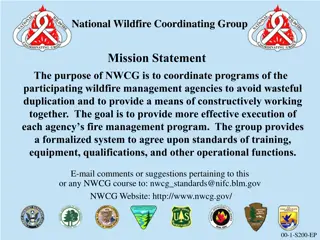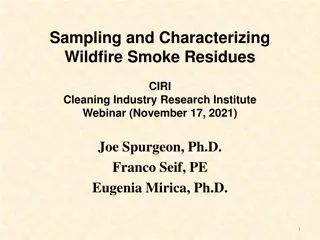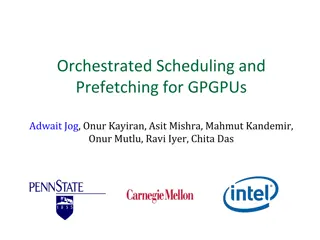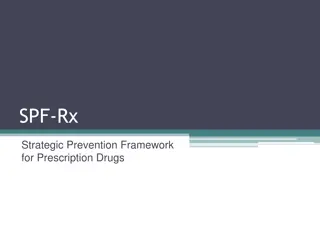Prescription Development and Scheduling in Wildfire Management
Explore the essential steps involved in developing prescriptions for prescribed fires, including identifying objectives, calculating fire behavior, and setting parameters. Learn about prescription variables, fire modeling outputs, and documentation requirements. Understand the importance of precise measurements for holding a prescribed fire within specific conditions. Dive into the process of creating effective prescriptions to meet operational and resource objectives in wildfire management.
Download Presentation

Please find below an Image/Link to download the presentation.
The content on the website is provided AS IS for your information and personal use only. It may not be sold, licensed, or shared on other websites without obtaining consent from the author.If you encounter any issues during the download, it is possible that the publisher has removed the file from their server.
You are allowed to download the files provided on this website for personal or commercial use, subject to the condition that they are used lawfully. All files are the property of their respective owners.
The content on the website is provided AS IS for your information and personal use only. It may not be sold, licensed, or shared on other websites without obtaining consent from the author.
E N D
Presentation Transcript
RX-300 Unit 7: Prescription Development and Scheduling RX-300 Unit 7: Prescription Development and Scheduling 1
Performance Standards Duties and Responsibilities Develop a prescription or verify that the prescription will meet operational and resource objectives. PMS 484-1 Elements Element 7: Prescription Element 8: Scheduling RX-300 Unit 7: Prescription Development and Scheduling 2
Learning Objectives Identify prescription variables that relate to the prescribed fire plan objectives. Demonstrate how fire modeling outputs may be used to develop prescriptions. Discuss how the assumptions and limitations in the fire spread model relate to prescribed fire. Describe ranges of acceptable prescription parameters and schedules that will produce fire behavior that meets prescribed fire and resource objectives and control limitations. List supporting documentation that may be required for the prescription. At the end of this unit, you will be able to answer the following questions: What are common prescription variables and how do you select the most meaningful ones? What are the possible structures of the prescription table? What is the process for calculating the prescription values? RX-300 Unit 7: Prescription Development and Scheduling 3
What is a Prescription? A prescription is the measurable criteria that define a range of conditions during which a prescribed fire may be ignited and held as a prescribed fire. PMS 484 RX-300 Unit 7: Prescription Development and Scheduling 4
Developing a Prescription RX-300 Unit 7: Prescription Development and Scheduling 5
Four Steps of Prescription Development Identify prescribed fire objectives Calculate fire behavior that accomplishes the objectives Develop prescription parameters using variables that best represent objectives and drivers of fire behavior Develop prescription narrative RX-300 Unit 7: Prescription Development and Scheduling 6
Demo: Fire Behavior that Meets Objectives Wide range of acceptable fire behavior? Narrow for control limitations Narrow range of acceptable fire behavior? Widen using innovation (ex. two stage burning) Revise objectives RX-300 Unit 7: Prescription Development and Scheduling 7
Select Meaningful Variables Just right Too hot Too cold What conditions in the past have led to acceptable fire behavior and effects? Build your fire behavior library with thorough documentation! RX-300 Unit 7: Prescription Development and Scheduling 8
Select Meaningful Variables Relate each variable to an objective Consider how it will be measured or recorded to show you are in prescription Fuel Weather Other RX-300 Unit 7: Prescription Development and Scheduling 9
Select Meaningful Variables Duff moisture content Time lag fuel moisture content 1-hour (fine dead fuel moisture) 10-hour 100-hour 1000-hour Fuel Weather Other Live herbaceous and woody fuel moisture content State of development for live vegetation What objective or sideboards relate to the variable? How can it be measured? RX-300 Unit 7: Prescription Development and Scheduling 10
Select Meaningful Variables Temperature Relative Humidity Fuel Wind speed Eye-level 20-foot Transport Weather Indices Wind direction Eye-level 20-foot Transport What objective or side-boards relate to the variable? RX-300 Unit 7: Prescription Development and Scheduling 11
Select Meaningful Variables Variable/Considerations for go-no go Fuel Days since rain Weather NFDRS Index Percentiles Other Hot-Dry-Windy Vapor Pressure Deficit Preparedness level What variables are most informative for your area? RX-300 Unit 7: Prescription Development and Scheduling 12
Select Meaningful Variables Evaluate your variables Extra, Duplicate, Missing? RX-300 Unit 7: Prescription Development and Scheduling 13
Justify Prescription Values Select a structure Cold end, Hot end Acceptable and Preferred Low, Medium, High Include fire behavior for prominent fuel models Beware of and - they are often confused Write out instead What structure does your plan use? RX-300 Unit 7: Prescription Development and Scheduling 14
Advantages and Disadvantages? RX-300 Unit 7: Prescription Development and Scheduling 15
Structure of the Prescription Table Element 7: Prescription Low Fire Intensity Medium Fire Intensity High Fire Intensity Fire Behavior Flame Length (feet) Scorch Height (feet) Spotting Distance (miles) Environmental Temperature ( F) Relative humidity (%) 20-foot winds (Forecasted) Mid-flame winds (Calculated from 20 ft) 1-hr fuel moisture (%) 10-hr fuel moisture (%) 1000-hr fuel moisture (%) 1-2 4-8 2-5 8-30 5-8 25-40 0-0.1 0.1-0.2 0.2-0.4 50-65 30-40 65-75 20-30 75-85 15-20 Less than 20 Less than 20 Less than 10 Less than 8 Less than 8 Less than 4 9-12 12-15 6-8 8-11 4-5 7-9 20-25 14-19 10-14 RX-300 Unit 7: Prescription Development and Scheduling 16
Break Take 5 RX-300 Unit 7: Prescription Development and Scheduling 17
Justify Prescription Values Source of information Experience of self or others Difficulty to obtain Easy Repeatability and scalability Low Accuracy Moderate (depending on experience) Unknown (past conditions may not apply to future) Past documentation Moderate (depending on quality of documentation) Moderate to hard (depending on skill) Moderate Modeling High Moderate best paired with experience Use multiple sources of information and understand their strengths, weaknesses, assumptions, and limitations RX-300 Unit 7: Prescription Development and Scheduling 18
Purpose of Modeling Purpose of fire modeling Give us the answers?? NO Lead us to the answers through directed exploration of variables?? YES What level of modeling is in your plan? RX-300 Unit 7: Prescription Development and Scheduling 19
BehavePlus Modeling Limitations NO 1. Do fire behavior output include crown fuels? Head 2. Fire modeling describes the fire behavior at the _______of the fire, during the _________phase of combustion. Flaming Uniform 3. Assumes Fuels, Weather, and Topography are _________ and ___________ Constant 4. Do fire models account for the effect of long-range spotting on the main fire behavior? NO Are models still useful? YES Do they require knowledge of the model limitations and assumptions, critical thinking and proper interpretation to make them useful? YES RX-300 Unit 7: Prescription Development and Scheduling 20
Modeling Workflow Setup a Workflow 1. Know your inputs 2. Set up modeling program 1. BehavePlus 2. FOFEM 3. IFTDSS 3. Calibrate 4. Get organized and get modeling 5. Adjust prescription based on outputs and experience 6. Report results Turn to the Position Specific Standards Document RX-300 Unit 7: Prescription Development and Scheduling 21
Modeling Outputs Report input conditions Choose relevant figures Consolidate if possible Consider what is added in the body vs. appendix of the plan How are your modeling outputs displayed? RX-300 Unit 7: Prescription Development and Scheduling 22
Prescription Narrative Not restate the prescription In your own words not copy and pasted Provide nuance of how to implement within the prescription Describe the likely and possible fire behavior Describe historical or unusual conditions or events that may influence fire behavior Resolve non-representative modeling outputs Exercise: Critique your prescription narrative RX-300 Unit 7: Prescription Development and Scheduling 23
Element 8: Scheduling Seasonality Time of day Sequence for implementing units Estimated number of shifts to complete Pick a time that will maximize objectives What do you do if the ideal conditions to meet objectives rarely occur? RX-300 Unit 7: Prescription Development and Scheduling 24
Modeling for Prescription Development Work on the prescription portion of the final project 1. Determine the fire behavior that will meet objectives 2. Select variables that inform the fire behavior and relate to objectives 3. Reorganize table structure to the specifications in the final. 4. Set the modules in Behave to provide outputs related to the objectives. 5. Use the existing prescription parameters as a starting place If there are details such as tree characteristics that you do not know, give your best estimate and be sure to report your inputs when you present your results. 6. Adjust prescription values, as necessary. 7. Select the most informative figures. 8. Create the narrative following guidance in PMS 484. RX-300 Unit 7: Prescription Development and Scheduling 25






















